remote start DACIA DUSTER 2010 1.G Owners Manual
[x] Cancel search | Manufacturer: DACIA, Model Year: 2010, Model line: DUSTER, Model: DACIA DUSTER 2010 1.GPages: 200, PDF Size: 7.12 MB
Page 8 of 200
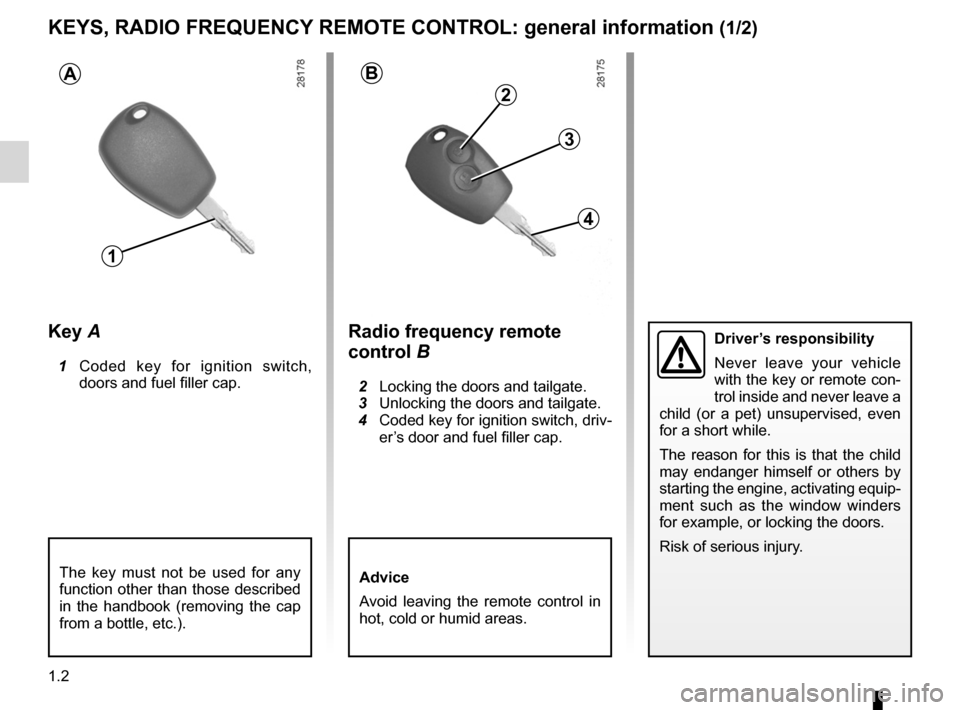
keys ...................................................... (up to the end of the DU)
remote control door locking unit ............................ (current page)
1.2
ENG_UD15850_1
Clé / Télécommande à radiofréquence : Généralités (H79 -\
Dacia)
ENG_NU_898-5_H79_Dacia_1
Jaune NoirNoir texte
Keys/Radio frequency remote control
KEYS, RADIO FREQUENCY REMOTE CONTROL: general information (1/2)
Radio frequency remote
control B
2 Locking the doors and tailgate.
3 Unlocking the doors and tailgate.
4 Coded key for ignition switch, driv-
er’s door and fuel filler cap.
Key A
1 Coded key for ignition switch,
doors and fuel filler cap.
The key must not be used for any
function other than those described
in the handbook (removing the cap
from a bottle, etc.).Advice
Avoid leaving the remote control in
hot, cold or humid areas.
Driver’s responsibility
Never leave your vehicle
with the key or remote con-
trol inside and never leave a
child (or a pet) unsupervised, even
for a short while.
The reason for this is that the child
may endanger himself or others by
starting the engine, activating equip -
ment such as the window winders
for example, or locking the doors.
Risk of serious injury.
1
2
3
4
AB
Page 23 of 200
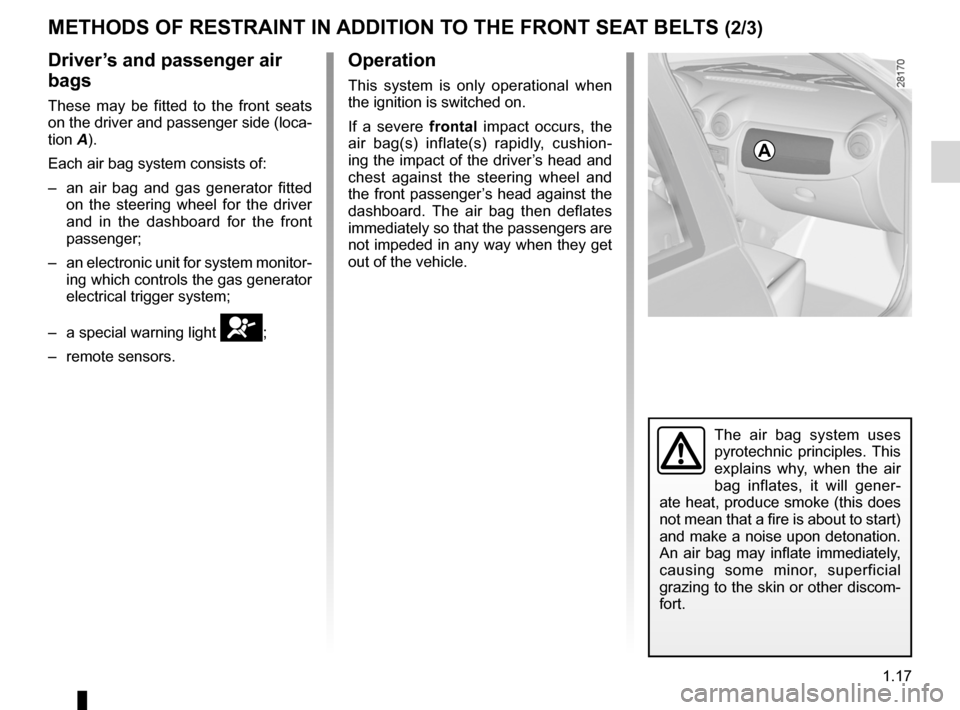
JauneNoirNoir texte
1.17
ENG_UD20682_3
Dispositifs complémentaires aux ceintures avant (H79 - Dacia)
ENG_NU_898-5_H79_Dacia_1
METHODS OF RESTRAINT IN ADDITION TO THE FRONT SEAT BELTS (2/3)
Driver’s and passenger air
bags
These may be fitted to the front seats
on the driver and passenger side (loca-
tion A).
Each air bag system consists of:
– an air bag and gas generator fitted
on the steering wheel for the driver
and in the dashboard for the front
passenger;
– an electronic unit for system monitor-
ing which controls the gas generator
electrical trigger system;
– a special warning light
å;
– remote sensors.
The air bag system uses
pyrotechnic principles. This
explains why, when the air
bag inflates, it will gener -
ate heat, produce smoke (this does
not mean that a fire is about to start)
and make a noise upon detonation.
An air bag may inflate immediately,
causing some minor, superficial
grazing to the skin or other discom-
fort.
Operation
This system is only operational when
the ignition is switched on.
If a severe frontal impact occurs, the
air bag(s) inflate(s) rapidly, cushion -
ing the impact of the driver’s head and
chest against the steering wheel and
the front passenger’s head against the
dashboard. The air bag then deflates
immediately so that the passengers are
not impeded in any way when they get
out of the vehicle.
A
Page 71 of 200
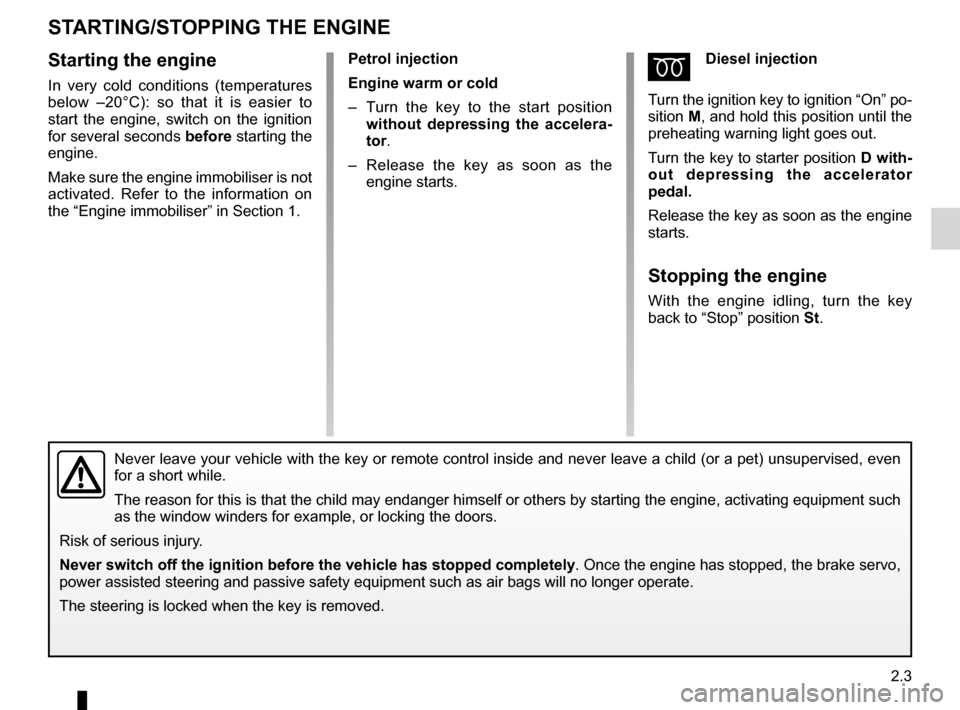
driving ................................................... (up to the end of the DU)
starting .................................................. (up to the end of the DU)
starting the engine ................................ (up to the end of the DU)
2.3
ENG_UD17439_2
Mise en route / Arrêt du moteur (H79 - Dacia)
ENG_NU_898-5_H79_Dacia_2
Petrol injection
Engine warm or cold
– Turn the key to the start position
without depressing the accelera -
tor.
– Release the key as soon as the
engine starts.ÉDiesel injection
Turn the ignition key to ignition “On” po-
sition M, and hold this position until the
preheating warning light goes out.
Turn the key to starter position D with-
out depressing the accelerator
pedal.
Release the key as soon as the engine
starts.
Stopping the engine
With the engine idling, turn the key
back to “Stop” position St.
Starting the engine
In very cold conditions (temperatures
below –20°C): so that it is easier to
start the engine, switch on the ignition
for several seconds before starting the
engine.
Make sure the engine immobiliser is not
activated. Refer to the information on
the “Engine immobiliser” in Section 1.
Starting/stopping the engine
STARTING/STOPPING THE ENGINE
Never leave your vehicle with the key or remote control inside and never leave a child (or a pet) unsupervised, even
for a short while.
The reason for this is that the child may endanger himself or others by starting the engine, activating equipment such
as the window winders for example, or locking the doors.
Risk of serious injury.
Never switch off the ignition before the vehicle has stopped completely. Once the engine has stopped, the brake servo,
power assisted steering and passive safety equipment such as air bags wi\
ll no longer operate.
The steering is locked when the key is removed.
Page 101 of 200
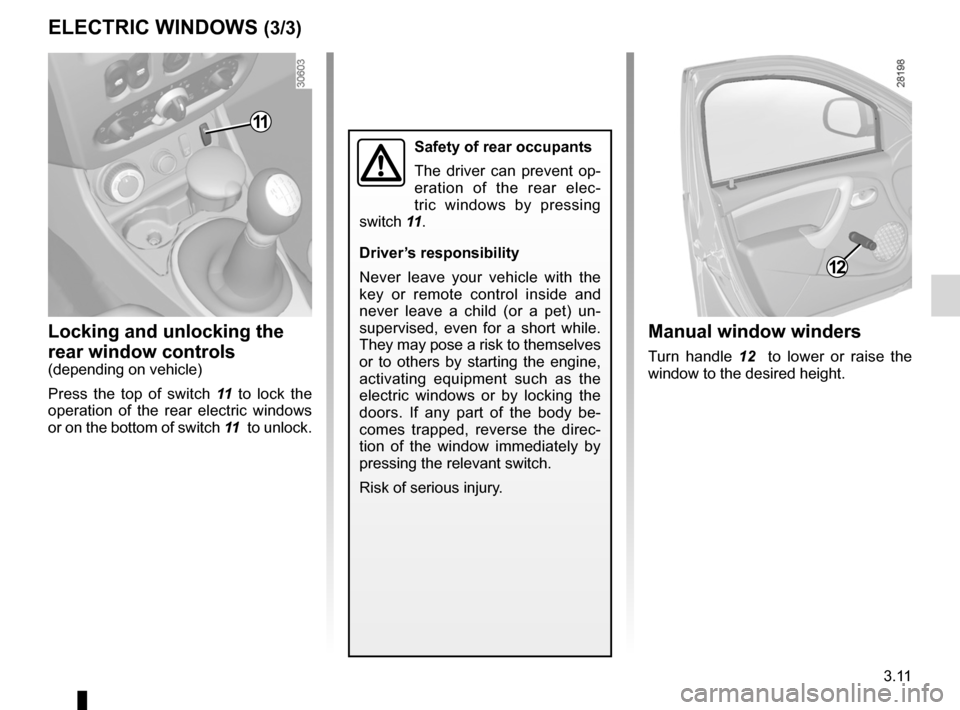
JauneNoirNoir texte
3.11
ENG_UD24508_3
Lève-vitres (H79 - Dacia)
ENG_NU_898-5_H79_Dacia_3
ELECTRIC WINDOWS (3/3)
Locking and unlocking the
rear window controls
(depending on vehicle)
Press the top of switch 11 to lock the
operation of the rear electric windows
or on the bottom of switch 11 to unlock.
Safety of rear occupants
The driver can prevent op -
eration of the rear elec -
tric windows by pressing
switch 11.
Driver’s responsibility
Never leave your vehicle with the
key or remote control inside and
never leave a child (or a pet) un -
supervised, even for a short while.
They may pose a risk to themselves
or to others by starting the engine,
activating equipment such as the
electric windows or by locking the
doors. If any part of the body be -
comes trapped, reverse the direc -
tion of the window immediately by
pressing the relevant switch.
Risk of serious injury.
11
Manual window winders
Turn handle 12 to lower or raise the
window to the desired height.
12
Page 102 of 200
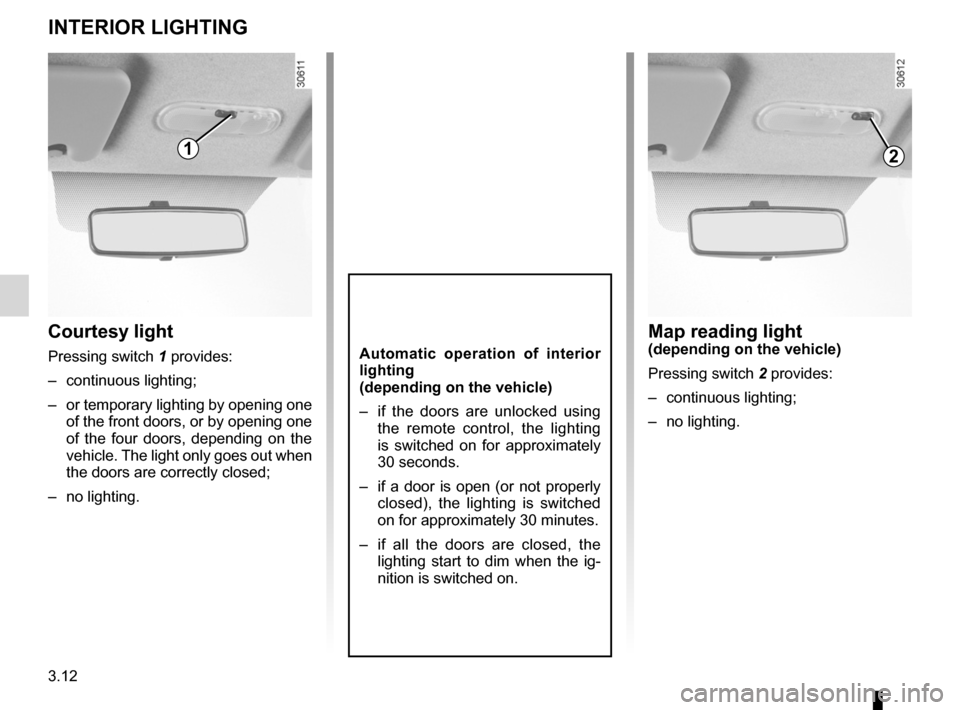
lighting:interior ............................................. (up to the end of the DU)
courtesy light ........................................ (up to the end of the DU)
3.12
ENG_UD20688_2
Eclairage intérieur (H79 - Dacia)
ENG_NU_898-5_H79_Dacia_3
Interior lighting
INTERIOR LIGHTING
Courtesy light
Pressing switch 1 provides:
– continuous lighting;
– or temporary lighting by opening one
of the front doors, or by opening one
of the four doors, depending on the
vehicle. The light only goes out when
the doors are correctly closed;
– no lighting.Automatic operation of interior
lighting
(depending on the vehicle)
– if the doors are unlocked using
the remote control, the lighting
is switched on for approximately
30 seconds.
– if a door is open (or not properly
closed), the lighting is switched
on for approximately 30 minutes.
– if all the doors are closed, the
lighting start to dim when the ig-
nition is switched on.
Map reading light(depending on the vehicle)
Pressing switch 2 provides:
– continuous lighting;
– no lighting.
12
Page 197 of 200
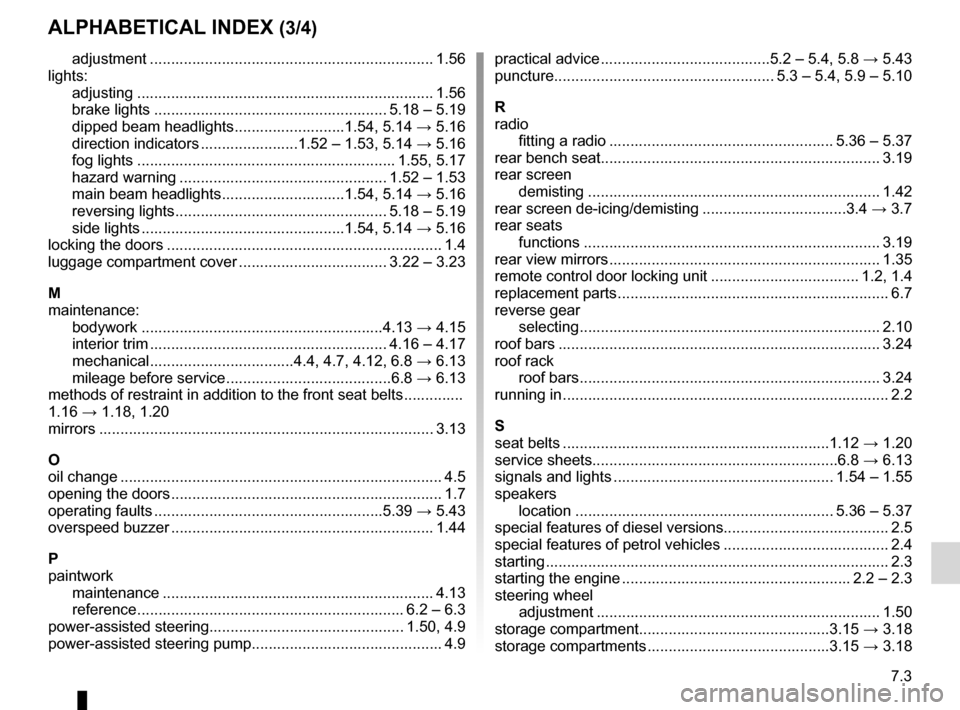
JauneNoirNoir texte
7.3
FRA_UD25066_7
Index (H79 - Dacia)
ENG_NU_898-5_H79_Dacia_7
AlphAbeticAl index (3/4)
adjustment ................................................................... 1.56
lights: adjusting ...................................................................... 1.56
brake lights ....................................................... 5.18 – 5.19
dipped beam headlights ..........................1.54, 5.14 → 5.16
direction indicators ....................... 1.52 – 1.53, 5.14 → 5.16
fog lights ............................................................. 1.55, 5.17
hazard warning ................................................. 1.52 – 1.53
main beam headlights ............................. 1.54, 5.14 → 5.16
reversing lights .................................................. 5.18 – 5.19
side lights ................................................ 1.54, 5.14 → 5.16
locking the doors ................................................................. 1.4
luggage compartment cover ................................... 3.22 – 3.23
M
maintenance: bodywork ......................................................... 4.13 → 4.15
interior trim ........................................................ 4.16 – 4.17
mechanical ..................................4.4, 4.7, 4.12, 6.8 → 6.13
mileage before service ....................................... 6.8 → 6.13
methods of restraint in addition to the front seat belts ..............
1.16 → 1.18, 1.20
mirrors ........................................................................\
....... 3.13
O
oil change ........................................................................\
.... 4.5
opening the doors ................................................................ 1.7
operating faults ...................................................... 5.39 → 5.43
overspeed buzzer .............................................................. 1.44
p
paintwork maintenance ................................................................ 4.13
reference ............................................................... 6.2 – 6.3
power-assisted steering .............................................. 1.50, 4.9
power-assisted steering pump .............................................4.9practical advice
........................................ 5.2 – 5.4, 5.8 → 5.43
puncture .................................................... 5.3 – 5.4, 5.9 – 5.10
R
radio fitting a radio ..................................................... 5.36 – 5.37
rear bench seat .................................................................. 3.19
rear screen demisting ..................................................................... 1.42
rear screen de-icing/demisting ..................................3.4 → 3.7
rear seats functions ...................................................................... 3.19
rear view mirrors ................................................................ 1.35
remote control door locking unit ................................... 1.2, 1.4
replacement parts ................................................................ 6.7
reverse gear selecting ....................................................................... 2.10
roof bars ........................................................................\
.... 3.24
roof rack roof bars ....................................................................... 3.24
running in ........................................................................\
..... 2.2
S
seat belts ............................................................... 1.12 → 1.20
service sheets .......................................................... 6.8 → 6.13
signals and lights .................................................... 1.54 – 1.55
speakers location ............................................................. 5.36 – 5.37
special features of diesel versions .......................................2.5
special features of petrol vehicles ....................................... 2.4
starting ........................................................................\
......... 2.3
starting the engine ...................................................... 2.2 – 2.3
steering wheel adjustment ................................................................... 1.50
storage compartment ............................................. 3.15 → 3.18
storage compartments ........................................... 3.15 → 3.18